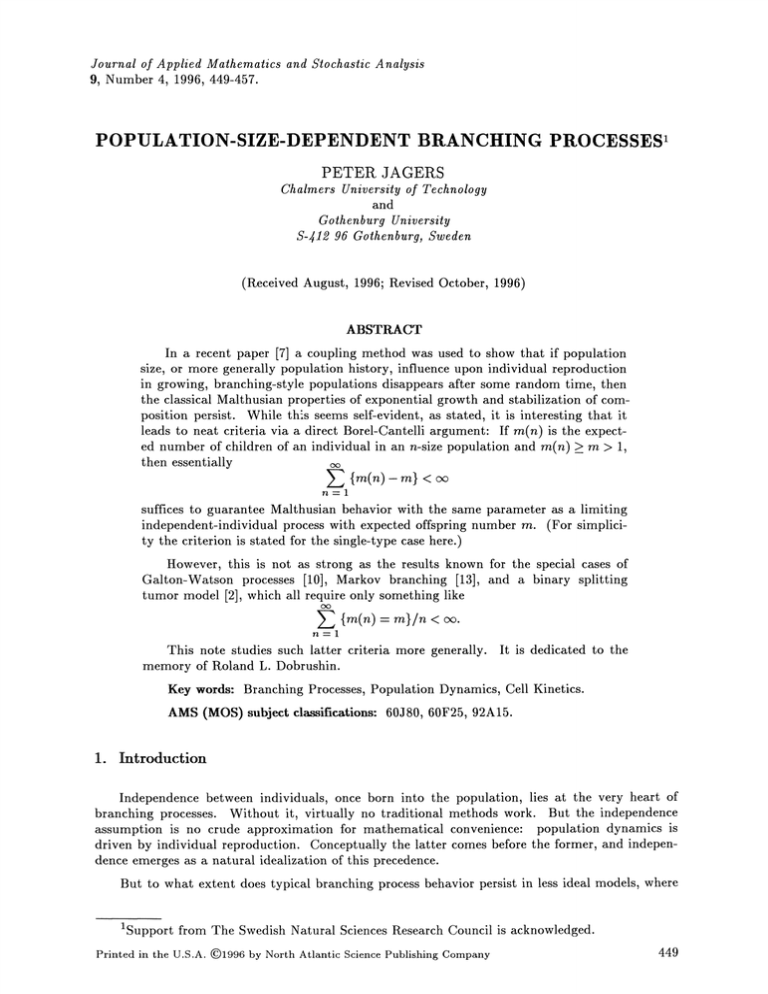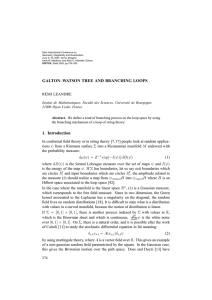PROCESSES BRANCHING POPULATION-SIZE-DEPENDENT PETER
advertisement

Journal of Applied Mathematics and Stochastic Analysis
9, Number 4, 1996, 449-457.
POPULATION-SIZE-DEPENDENT BRANCHING PROCESSES
PETER JAGERS
Chalmers University of Technology
and
Gothenburg University
S-12 96 Gothenburg, Sweden
(Received August, 1996;
Revised October,
1996)
ABSTPCT
In a recent paper [7] a coupling method was used to show that if population
size, or more generally population history, influence upon individual reproduction
in growing, branching-style populations disappears after some random time, then
the classical Malthusian properties of exponential growth and stabilization of composition persist. While this seems self-evident, as stated, it is interesting that it
leads to neat criteria via a direct Borel-Cantelli argument: If re(n) is the expected number of children of an individual in an n-size population and re(n) >_ m > 1,
then essentially
n=l
suffices to guarantee Malthusian behavior with the same parameter as a limiting
independent-individual process with expected offspring number m. (For simplicity the criterion is stated for the single-type case here.)
However, this is not as strong as the results known for the special cases of
Galton-Watson processes [10], Markov branching [13], and a binary splitting
tumor model [2], which all require only something like
. }ln < oo.
n--1
This note studies such latter criteria more generally. It is dedicated to the
memory of Roland L. Dobrushin.
Key words: Branching Processes, Population Dynamics, Cell Kinetics.
AMS (MOS) subject classifications: 60J80, 60F25, 92A15.
1. Introduction
Independence between individuals, once born into the population, lies at the very heart of
branching processes. Without it, virtually no traditional methods work. But the independence
assumption is no crude approximation for mathematical convenience: population dynamics is
driven by individual reproduction. Conceptually the latter comes before the former, and independence emerges as a natural idealization of this precedence.
But to what extent does typical branching process behavior persist in less ideal models, where
1Support from The Swedish
Printed in the U.S.A.
Natural Sciences Research Council is acknowledged.
@1996 by North Atlantic
Science Publishing Company
449
PETER JAGERS
450
there is interaction between individuals, or between the population as a whole and individual
behavior? We study an aspect of this in the supercritical case, viz. the persistence of Malthusian
exponential growth, and the ensuing Eulerian stabilization of composition.
In a seminal paper, Klebaner [10] managed to include population size dependence into simple
Galton-Watson processes: Presume that the expected reproduction by an individual belonging to
a generation of size n is rn(n)rn > 1, then, besides some technical side conditions,
{re(n)-
<
suffices to guarantee that the population in generation k, zk, grows as rn k.
It is interesting that Gyllenberg and Webb [2] have established essentially the same criterion
for balanced exponential growth of a Bell-Anderson type tumor model, where newborn cells can
move into (and out of) quiescence at a tumor-size dependent rate. We shall discuss an agedependent variation of this" When a cell is born, assume that it enters the so-called G o state of
eternal quiescence with a probability 1- p(n), where n is the population (i.e., tumor) size at the
moment of birth. Otherwise, with probability p(n) the cell embarks upon the cell cycle, which is
assumed to have i.i.d, lengths with an arbitrary but continuous distribution function, and ends by
cell division. It is assumed that the growth rate decreases with tumor size, so that 1 >_
p(n)p > 1/2, as ncx. The Gyllenberg and Webb condition for the same balanced exponential
growth as would have been the case in a tumor-size independent model, p(n)- p, would then be
{p(,,)-
<
As rn(n)- 2p(n) in these binary splitting models, it
seems that Klebaner and Gyllenberg and
also
Webb have spotted a condition which is fundamental
in a broader perspective.
In [7] population history dependence was investigated quite generally, by a coupling of individual reproductions to those of a limiting independent-reproduction branching population. For the
special case of population-size-dependent single-type populations, the (necessary and sufficient)
condition for success of that coupling, however, turned out to be of the form
In this note we investigate to what extent the weaker conditions suffice more generally. A
general growth condition, the first inequality of Theorem 1, is formulated to express the property
that in a growth tree no node may be expected have a much bigger daughter tree than the other
nodes on the same level. This seems to be the conceptual background of the 1/n-factor, n being
the number of nodes at a level.
2. Framework
Let us recall the setting, as given in [5]. Let
Un
o Nn, NO {0},N- {1,2,...}
denote the Ulam-Harris space of all possible individuals. Think of the population as initiated by
an Eve, whose name in I is 0, and the x(k):
(x,k)e I as x’s kth child, twins, etc. numbered in
an arbitrary way. Assume that each x E I has a reproduction process (x, giving x’s age at her
successive child-bearings and the types of the children then born, the latter being elements of a
type space (S,) with a countably generated r-algebra.
I-
a sequence of maps (7x(k),Crx(k)),k- 1,2,...,0 _< -(1) _<
values
with
S and the interpretation that rx(k is x’s age at giving birth to her kth child
in
rz(k)
and crx(k is that child’s type. Of course, if rx(k <
Thus, there is
Population-Size-Dependent Branching Processes
451
children, and the corresponding individuals in I are not realized. Clearly,
x(A x B) #{k e I; rx(k
E A, 7x(k
B}.
The birth time and type of an individual x G I are denoted by r x and
inductively given from a starting type r 0 G S and 70 0.
rx,
respectively. These are
Population size can be measured by random characteristics, i.e., at time t the individual x is
assumed to have some weight Xx(rx, t-Vx) where, Xx is a functional X as evaluated on x’s
daughter process. More precisely, define S x to be the coordinate projection, restricting attention
from the space of all lives to only the life of x and all her progeny. In other words, S x renders x
the ancestor in a space, which otherwise has the same structure as the original space f of all
possible life careers of all possible individuals. A characteristic is a measurable map X: S x
x
o
D-valued
which
its
is
second
as
in
interpreted
age.
coordinate,
Further,
f---,N+,
X: -X S.
Thus, an individual’s weight, once her type and age are given is determined by her own life, and
possibly her progeny’s lives. We assume characteristics to be nonnegative, bounded, and
or 1A x
vanishing for negative ages. Typical characteristics would be lq x
a)] for
+
R+
A
[O,min(,kx,
if. Such characteristics, and many other, are individual in the sense that they actually depend
only upon x’s own life, type, and age, and remain unaffected by x’s progeny.
The
X-counted population size at
time t is then defined as
xEI
Thus, the characteristic 1 S x R_, yields the total population, i.e., all those born, and the other
characteristic mentioned gives tge number of those alive of type A and not older than a. Though
it is important to vary the characteristics, in order to catch the asymptotic composition of the
population, we shall usually consider a fixed but arbitrary such entity X, and then sometimes
write just z for
ztX.
In the classical case of independent reproduction, the reproduction process depends upon the
past only through the individual type and the form of supercritical population growth is essentially governed by the reproduction kernel #, defined as the expected number births of children of
various types and at various ages:
.
Er[(ds x dt)],
#(r, ds x dt):
r being the type of the individual with reproduction
The usual assumption is that the population is Malthusian and supercritical, this meaning that there is a number a > 0, the Malthusian
parameter, such that the kernel ’(c),
"fi(r, ds;a):
/
e-Ct#(r, ds x dt)
0
has Perron root one and is what Shurenkov [24] calls conservative. (This corresponds to irreducibility and o-recurrence in the terminology of [18].) By the abstract Perron-Frobenius theorem
([24, p. 43] or [9, p. 7O], there is then a -finite measure on the type space (S, if), and strictly
positive a.e., [zr] finite measurable function h on the same space, such that
S
Further, strong
or positive a-recurrence in the sense that h C
Ll[Tr] is required and
PETER JAGERS
452
0
<
]
x dt)r(dr)
oo.
SxSxR /
(In population
ing.) Then,
dynamics this entity might be interpreted as the long-run stable age at childbear
one norms to
hdr
1
s
and makes the homogeneity assumption that infh > 0. Then is finite and can (and will) also be
normed to a probability measure. These are the conditions (i.e., those concerning ) for the
general Markov renewal theorem of [24, p. 107], which in the non-lattice case lead to the expected
asymptotics
as t.
(Here hat denotes the Laplace transform,
so that
/
*)dt,
0
,
where q denotes the type, following the stable type distribution
as indicated by the suffix of
the expectation,
and
the
necessary direct-Riemann-type regularity assumptions
f,(ds),
:
s
on the expected characteristic are tacitly
presumed.)
The fundamental finding of the theory of general, supercritical branching processes is that
under very broad conditions, this leads on to a similar behavior of the process itself, in L 1, L 2, in
probability, or a.s. for -almost-all
where w is a random variable, vanishing precisely if the process dies out and with mean value
s[w] h(s). The fact that this holds for many different X’S is what is referred to as balanced
poueulial growth in certain branches of biology and as asynchronous exponeniial growlh in (deterministic) mathematical population dynamics. Here we shall bypass the technical conditions for
such growth (cf. [5]), and instead assume directly that the limiting, classical independent-individual, branching population exhibits balanced exponential growth. Somewhat inadvertently, we
shall summarize this by referring to the (latter) population as (non-lattice) Malthusian, adding
the particular character of the asymptotics (a.s., in probability, or in the mean) whenever necessary. The populations under study will be referred to as actual or history-dependent. It will be
assumed that they are always finite (at finite times). If they exhibit the exponential asymptotics
of the formula above they will also be called Malthusian and the entities a, h, and will be referred to as their Malthusian parameter, fitness function and stable type distribution, respectively, as
for populations with independently acting individuals.
=
By the assumption that history-dependent populations remain finite at finite times, individuals can be numbered as they appear, starting from the ancestor
and continuing X2, X3, ...,
simultaneously born individuals if any- so numbered that progeny can never precede their
ancestors. A filtration {n} of a-algebras is defined by letting
be generated by the complete
lives of all individuals X1, X2,... X n. Define
by
X
x
A
0A {X x}
_,
n
x
for all n. If no individuals are ever born together, this means that
is the a-algebra generated
by the complete lives of all individuals born before x. The reason for this seemingly complicated,
stopping line type definition is to cover possible simultaneous births. The time f x when x E I is
born is measurable with respect to
as is x’s type a x (with a suitable convention for never real-
x,
Population-Size-Dependent Branching Processes
ized
453
individuals).
We consider the situation where individual reproduction tends to exceed what it would have
been in an imaginary infinite population, "tends to exceed" being interpreted as "stochastically
larger than". In other words, if x E I, v x < oo, and r/ is a generic imaginary reproduction point
process, then the basic assumption is that for all u and sets A, B,
F(x(A x B) > u [Ox) >- e x (q(A x B) > u),
where the right-hand-side F-suffix indicates the dependence upon type of reproduction a general
branching process. Let px denote a regular version of the conditional distribution, given
supposed to exist. By Strassen’s theorem [16, p. 129] we may assume that for each x E I, there is
a pair of reproduction point processes (x,x) such that
is x’s original reproduction, whereas
is
the
the
were
"if
reproduction,
population
already
imaginary
infinite," and P(z _> rx)- 1
rx
is the obvious partial order of measures. By an Ionesco-Tulcea construction (cf. [5]) we may
assume that the pairs (x,rx) are defined on a joint population probability space with the proper
conditional distributions and still satisfying
_> r a.s.
x,
x
3. Results
x
The ordering
>-r/x means that the imaginary reproduction can be thought of as arising
from the actual, population-history-dependent reproduction through abortion of some children.
Write 5 x to indicate abortion or not of x, so that
rx(A x B)
E (1
k=l
xk)l{rx(k) e A, ax(k) e B}
--recall the definitions of age at kth bearing, and type of the child then born; the Ulam-Harris
numbering consistently refers to the actual population. Note that the latter is not affected by the
value of
and the actual population are independent. Define
so that given
x, x
x,
and write
e(Zrx
for c x in case of population-size dependence.
We wish to study how dependence mirrors itself in population growth. Therefore, the way of
measuring the latter, the characteristic Xx should not itself be affected by the population history,
or those
except through individual type. And indeed natural characteristics are not, like 1S x
counting the number of individuals of certain types,
1A x N
+’A .
N+’
And the live population,
counted by 1S x[0,.x], is of this form, provided life span is independent of the population, given
type and future reproductions.
We shall call
the reproductions
conditionally population independent, if given x’s type r x and all
of individuals x’ stemming from x, the k:x’s are i.i.d.
a characteristic
x’
Theorem 1: Let {zt } be the population as counted by a conditionally population independent
characteristic X. Assume that reproductions
are finite and stochastically minorized by the
reproductions of a general Malthusian branching population with the finite reproduction kernel #
(defining the Malthusian parameter c stable type distribution r and fitness h). Assume that
w t"
is tight.
e
at_ztX
Further, suppose that for some constant K
for
all x G I and
> O,
and that
PETER JAGERS
454
Then, W tends in probability to some finite w >_ O, not identically zero.
We shall refer to the basic inequality
(for all t >_ 0 on the set of non-extinction, or in a suitable interpretation
condition of symmetric growth.
otherwise)
as the
The theorem has one immediate and two less direct corollaries:
Corollary 2: In the population-size dependent case, besides tightness and symmetric growth
the characteristic being conditionally population independent) assume that
]--O(n),
n
and that e(t)/t is ultimately concave, as t-,oc. Then
IFs[ZXrx
(and
<
implies that Malthusianess carries over.
-z- z[t],
Corollary 3: For population-size-dependent Galton-Watson processes with z
re(n) denoting the expected number of individual offspring in a generation of size n,
for
a non-zero random variable
an
w, provided e can be interpreted as concave.
For the tumor example, we need a concept of growth fraction: Let c be the number of
cycling cells at time t and z the total tumor size, i.e., cycling plus quiescent cells. The growth
fraction is called strictly positive if lim suPTE[zT/cT] < cx, the limsup being over larger and
larger stopping times.
Corollary 4: Provided it has a strictly positive growth fraction and the process w t" -e-Ctz
is tight, then the cell age and tumor size dependent growth model exhibits balanced exponential
growth with the same Malthusian parameter a as the limiting non-tumor-size dependent model,
provided only
<
Proof of the theorem: First some notation: Twiddled processes count only imaginary
individuals, ~x
zt r (x) thus standing for the imaginary process starting from the individual x in
x
-e-a(t-rx)z
(~
the actual population at time r x. Similarly, wtX_ (x):
r (x) etc.
x
rx
u
For any u, z recorded the summed X-values at time + u of all individuals born up to u and
all individuals not stemming from an aborted individual after u. If 5xu- 0 precisely if x stems
from an x’ with r x, > u and 5 x, 1, and 5xu- 1 otherwise, thus
In analogy with other notation,
Clearly,
and
Thus for any
c’, v > O,
w"
rx<_t+u
e -a(t + U)z.
Population-Size-Dependent Branching Processes
wFl > ’, w / <_ v) <_ (v/’)=[
( w/
Vx>U
lzx
S. But
for all t and starting types s
1+-71 + I-,1 + I,+
I+-,+1
Since
-.
Wt
x
as
455
Iu
Xwt + u
v
x
(),
()
Iu
x
t--,oo, the twiddled daughter processes being independent individual super-criticM branching
process with Malthusian parameter a, it follows that
w- ’,1 > ,’)
lira P s(
t--, oo
Hence,
limsupP(
t,
cxz
we +
we, +
Av
Av
0.
> ’) _< 2(vl’)K_[
v
x
>u
:lz$ x ].
Since u can be chosen as to render the right-hand side arbitrarily small, the convergence in probaVI
bility follows by completeness and tightness.
Proof of Corollary 3: The characteristic used to count the numbers in different generations is
As m(n)c(n) m(n)- m and 1 < m < re(n) < re(l), the
trivially population independent.
symmetry: Let
equivalence of the two conditions is obvious. Symmetric growth follows by
x E N k so that v x- k and Ox- %k, the r-algebra generated by the first k generations. With
t-n
E[ztX_ ()lz gx] E[z_ ()lz I]- l lz,
x
since
z,
;k
xE
if
z_ (z) a
zl
z,
%k is the set of realized individuals in the kth generation/
To get hold of
n_[(Zrx )/Zrx
]< cxz,
note that
n
ZkC=Yk-1 < n <_ Yk,
ZvXn
kj =oZj is the total population up to k.
where Yk:
(z
n
Thus,
,z(z)/z,
k
Xn )/z.x n
and
e[(’x )/Z’x]- e[(z)]
n
n
-<
7[(zk)] <
k
k
Y (m(1)k),
k
which converges precisely if
n(n)/n < ee by an elementary analytic lemma, cf. [11]. The same
condition and a similar analytic argument yield -[w] < o,z, and hence tightness (Theorem 5 of op.
cir.).
Proof of Corollary 4: In this case, it is the growth of z
the symmetric growth inequality causes difficulties. Indeed,
rxn that is directly mastered, whereas
zr
X1
-1 z r
X2
ZTX3 -2
zr
X4 -Zrx 5
-3,.. z r
X2n
=z r
X2n + 1
=n+l
_
456
PETER JAGERS
on the set where the population does not die out.
characteristic is obvious again.)
(Conditional population independence of the
For any x E I with v x < cx, define the set
A x" {x’ I; "r x, r x and a daughter of x’ cycles at
By the line [5, 17] property of Ax,
z_
E Ax
x
x
rx} U {x}.
,(’) <_z.
The inequality comes from the quiescent cells born before those in A x.
But the z u(x’)’s do not decrease in u whereas p(s) does not increase in s:
>
xEA x
But
Axl must be
to prove that
_[z t_,.,(’)/z )Ox] >
>_c r x /2. It
lAx E[zt_ .(x)/zt Ox].
is clear from the proof of the theorem that now it only remains
But
n
[()/Cx
< c.
n
Ic. x
]~ (,)
c[(,)/c.
,..e(n)/n
by the assumption of a strictly positive growth factor.
Remarks:
1. It could well be argued that population size dependence in the form of an albeit imaginary
abortion probability should be on z r
rather than on z r so that those born at the very same
x
x
instant as x do not influence its destiny. This would matter in lattice cases, like the Galton-Watson process. But conceptually, it is a minor variation only.
2. If there is strong symmetric growth, say in the sense that
Es[spztx_ ..()/zt
on the set of
g] < K/z}
non-extinction, a.s. Malthusianess would transfer as well.
References
Cohn,H. and Klebaner, F., Geometric rate of growth in Markov chains with applications to
population-size-dependent models with dependent offspring, Stoch. Anal. Appl. 4 (1986),
283-307.
[2]
[]
[4]
Gyllenberg, M. and Webb, G.F., A nonlinear structured population model of tumor growth
with quiescence, J. Math. Biol. 28 (1990), 671-694.
Gyllenberg, M. and Webb, G.F., Asynchronous exponential growth of semigroups of
nonlinear operators, J. Math. Anal. Appl. 167:2 (1992), 443-467.
Jagers, P., Branching Processes with Biological Applications, J. Wiley and Sons, Chichester 1975.
Jagers, P., General branching processes
as Markov
fields, Stoch. Proc. Appl. 32:2 (1989),
183-212.
[6]
Jagers, P., Towards dependence in general branching processes, In: Classical and Modern
Branching Processes (ed. by K. Athreya and P. Jagers), Springer-Verlag, New York 1997.
Population-Size-Dependent Branching Processes
[7]
457
Jagers, P., Coupling and population dependence in branching processes, Dept. of
Mathematics, Chalmers University of Technology and Gothenburg University
(1996),
submitted.
IS]
Keller, G., Kersting, G. and RSsler, U., On the asymptotic behavior of discrete time stochastic growth processes, Ann. Prob. 15 (1987), 305-343.
Kersting, G., On recurrence and transience of growth models, J. Appl. Prob. 23 (1986),
614-625.
[o]
[11]
Klebaner, F., Geometric rate of growth in population-size-dependent branching processes,
J. Appl. Prob. 21 (1984), 40-49.
Klebaner, F., A limit theorem for population-size-dependent branching processes, J. Appl.
Prob. 22:11
[12]
[13]
[14]
(1985), 48-57.
Klebaner, F., Geometric growth in near-supercritical population size dependent multitype
GMton-Watson processes, Ann. Prob. 17:4 (1989), 1466-1477.
Klebaner, F., Asymptotic behavior of Markov population processes with asymptotically
linear rate of change, J. Appl. Prob. 31 (1994), 614-625.
[15]
K/ister, P., Generalized Markov branching processes with state-dependent offspring distribution, Z. Wahr. verw. Geb. 64 (1983), 475-503.
K/ister, P., Asymptotic growth of controlled Galton-Watson processes, Ann. Prob. 13:4
[16]
[17]
(1985), 1157-1178.
Lindvall, T., Lectures on the Coupling Method, Wiley, Chichester 1992.
Neveu, J., Arbres et processus de Galton-Watson, Ann. Inst. It. Poincar 22 (1986), 199207.
[18]
[9]
[20]
[21]
[22]
[23]
[24]
Niemi, S. and Nummelin, E., On non-singular renewal kernels with an application to a
semigroup of transition kernels, Stoch. Proc. Appl. 22 (1986), 177-202.
Nummelin, E., General Irreducible Markov Chains and Non-negative Operators, Cambridge University Press, Cambridge 1984.
Olofsson, P., General Branching Processes with Local Dependencies, Thesis, Dept. of
Math., Chalmers and Gothenburg Univ. 1994.
Olofsson, P., Branching processes with local dependencies, Ann. Appl. Prob. (1996), to
appear.
Rittgen, W., /0ber das qualitative Verhalten populationsabhngiger Markoffscher
Verzweigungsproxesse, Fachbereich Mathematik der lohannes-Gutenberg-Universitgt,
Mainz 1986.
Sevast’janov, B.A. and Zubkov, A.M., Controlled branching processes, Teor. Veroyat.
Primen. 19 (1974), 15-25.
Shurenkov, V.M., Ergodieskie Processy Markova (Ergodic Markov Processes), Nauka,
Moscow 1989.





![Branching Out: An Introduction to Family History [pptx , 2.3 MB]](http://s2.studylib.net/store/data/005232376_1-8bb1ea3bff509441ce8b545117622545-300x300.png)